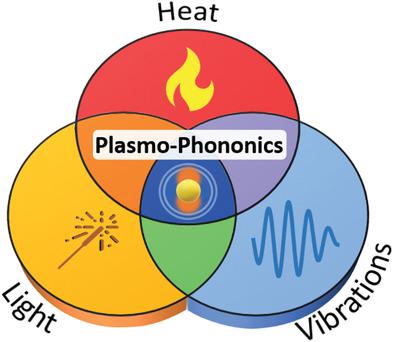当前位置:
X-MOL 学术
›
Adv. Opt. Mater.
›
论文详情
Our official English website, www.x-mol.net, welcomes your
feedback! (Note: you will need to create a separate account there.)
Controlling Light, Heat, and Vibrations in Plasmonics and Phononics
Advanced Optical Materials ( IF 8.0 ) Pub Date : 2020-11-17 , DOI: 10.1002/adom.202001225 Joao Cunha 1, 2 , Tian‐Long Guo 1 , Giuseppe Della Valle 3 , Alemayehu Nana Koya 4 , Remo Proietti Zaccaria 1, 4 , Alessandro Alabastri 5
Advanced Optical Materials ( IF 8.0 ) Pub Date : 2020-11-17 , DOI: 10.1002/adom.202001225 Joao Cunha 1, 2 , Tian‐Long Guo 1 , Giuseppe Della Valle 3 , Alemayehu Nana Koya 4 , Remo Proietti Zaccaria 1, 4 , Alessandro Alabastri 5
Affiliation

|
Plasmonic nanostructures have attracted considerable attention for their ability to couple with light and provide strong electromagnetic energy confinement at subwavelength dimensions. The absorbed portion of the captured electromagnetic energy can lead to significant heating of both the nanostructure and its surroundings, resulting in a rich set of nanoscale thermal processes that defines the subfield of thermoplasmonics with applications ranging from nanochemistry and nanobiology to optoelectronics. Recently, phononic nanostructures have started to attract attention as a platform for manipulation of phonons, enabling control over heat propagation and/or mechanical vibrations. The complex interaction phenomena between photons, electrons, and phonons require appropriate modelling strategies to design nanodevices that simultaneously explore and exploit the optical, thermal, and mechanical degrees of freedom. Examples of such devices are micro‐ and nanoscale opto‐thermo‐mechanical systems for sensing, imaging, energy conversion, and harvesting applications. Here, an overview of the fundamental theory and concepts crucial to the modelling of plasmo‐phonon devices is provided. Particular attention is given to micro‐ and nanoscale modelling frameworks, highlighting their validity ranges and the experimental works that contributed to their validation and led to compelling applications. Finally, an open‐ended outlook focused on emerging applications at the intersection between plasmonics and phononics is presented.
中文翻译:

控制等离子和声子学中的光,热和振动
等离子体纳米结构因其与光耦合并在亚波长范围内提供强大的电磁能限制而备受关注。捕获的电磁能的吸收部分可导致纳米结构及其周围环境显着加热,从而导致一系列丰富的纳米级热过程,这些过程定义了热等离子体的子领域,其应用范围从纳米化学,纳米生物学到光电子学。近来,声子纳米结构作为用于操纵声子的平台开始引起人们的注意,从而能够控制热传播和/或机械振动。光子,电子,声子和声子需要适当的建模策略来设计可同时探索和利用光学,热和机械自由度的纳米器件。这种设备的例子包括用于传感,成像,能量转换和收集应用的微米级和纳米级光电热机械系统。这里,提供了对等离激子声子器件建模至关重要的基本理论和概念的概述。特别关注了微米级和纳米级建模框架,突出了它们的有效性范围和有助于其验证并引人注目的应用的实验工作。最后,提出了一种开放式的观点,重点放在等离子与声子相交处的新兴应用上。这种设备的例子包括用于传感,成像,能量转换和收集应用的微米级和纳米级光电热机械系统。这里,提供了对等离激子声子器件建模至关重要的基本理论和概念的概述。特别关注了微米级和纳米级建模框架,突出了它们的有效性范围和有助于其验证并引人注目的应用的实验工作。最后,提出了一种开放式的观点,重点放在等离子与声子相交处的新兴应用上。这种设备的例子包括用于传感,成像,能量转换和收集应用的微米级和纳米级光电热机械系统。这里,提供了对等离激子声子器件建模至关重要的基本理论和概念的概述。特别关注了微米级和纳米级建模框架,突出了它们的有效性范围和有助于其验证并引人注目的应用的实验工作。最后,提出了一种开放式的观点,重点放在等离子与声子相交处的新兴应用上。提供了对等离激子器件建模至关重要的基本理论和概念的概述。特别关注了微米级和纳米级建模框架,突出了它们的有效性范围和有助于其验证并引人注目的应用的实验工作。最后,提出了一种开放式的观点,重点放在等离子与声子相交处的新兴应用上。提供了对等离激子器件建模至关重要的基本理论和概念的概述。特别关注了微米级和纳米级建模框架,突出了它们的有效性范围和有助于其验证并引人注目的应用的实验工作。最后,提出了一种开放式的观点,重点放在等离子与声子相交处的新兴应用上。
更新日期:2020-12-17
中文翻译:

控制等离子和声子学中的光,热和振动
等离子体纳米结构因其与光耦合并在亚波长范围内提供强大的电磁能限制而备受关注。捕获的电磁能的吸收部分可导致纳米结构及其周围环境显着加热,从而导致一系列丰富的纳米级热过程,这些过程定义了热等离子体的子领域,其应用范围从纳米化学,纳米生物学到光电子学。近来,声子纳米结构作为用于操纵声子的平台开始引起人们的注意,从而能够控制热传播和/或机械振动。光子,电子,声子和声子需要适当的建模策略来设计可同时探索和利用光学,热和机械自由度的纳米器件。这种设备的例子包括用于传感,成像,能量转换和收集应用的微米级和纳米级光电热机械系统。这里,提供了对等离激子声子器件建模至关重要的基本理论和概念的概述。特别关注了微米级和纳米级建模框架,突出了它们的有效性范围和有助于其验证并引人注目的应用的实验工作。最后,提出了一种开放式的观点,重点放在等离子与声子相交处的新兴应用上。这种设备的例子包括用于传感,成像,能量转换和收集应用的微米级和纳米级光电热机械系统。这里,提供了对等离激子声子器件建模至关重要的基本理论和概念的概述。特别关注了微米级和纳米级建模框架,突出了它们的有效性范围和有助于其验证并引人注目的应用的实验工作。最后,提出了一种开放式的观点,重点放在等离子与声子相交处的新兴应用上。这种设备的例子包括用于传感,成像,能量转换和收集应用的微米级和纳米级光电热机械系统。这里,提供了对等离激子声子器件建模至关重要的基本理论和概念的概述。特别关注了微米级和纳米级建模框架,突出了它们的有效性范围和有助于其验证并引人注目的应用的实验工作。最后,提出了一种开放式的观点,重点放在等离子与声子相交处的新兴应用上。提供了对等离激子器件建模至关重要的基本理论和概念的概述。特别关注了微米级和纳米级建模框架,突出了它们的有效性范围和有助于其验证并引人注目的应用的实验工作。最后,提出了一种开放式的观点,重点放在等离子与声子相交处的新兴应用上。提供了对等离激子器件建模至关重要的基本理论和概念的概述。特别关注了微米级和纳米级建模框架,突出了它们的有效性范围和有助于其验证并引人注目的应用的实验工作。最后,提出了一种开放式的观点,重点放在等离子与声子相交处的新兴应用上。











































 京公网安备 11010802027423号
京公网安备 11010802027423号